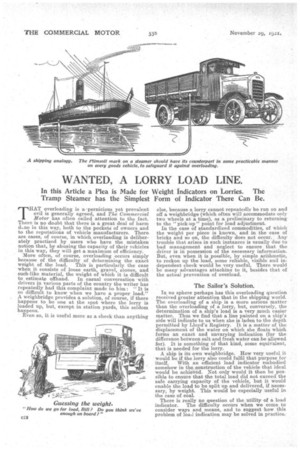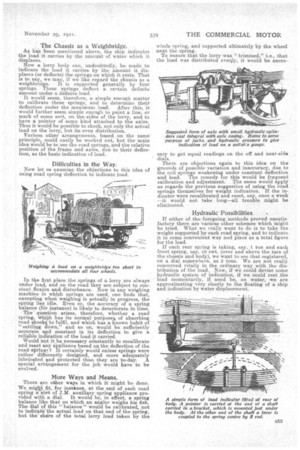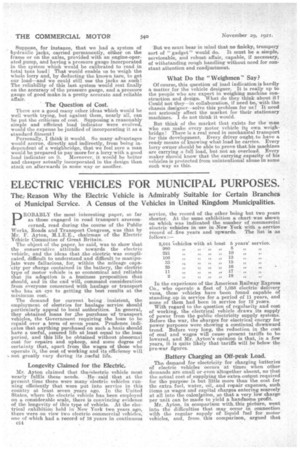WANTED, A LORRY LOAD LINE.
Page 10

Page 11

Page 12

If you've noticed an error in this article please click here to report it so we can fix it.
In this Article a Plea is Made for Weight indicators on Lorries. The Tramp Steamer has the Simplest Form of Indicator There Can Be.
THAT overloading is a, 'pernicious yet prevalent evil is generally agreed, and The Commercial Motor has often called attention to the fact. There is no doabt that there is a great deal of harm &no in this way, both to the pockets of owners and to the reputations of vehicle manufacturers. There are cases, of course, in which.overloading is deliberately practised by users who have the mistaken notion that, by abusing the capacity of their vehicles in this way, they will, get a maximum of efficiency. More often, of course, overloading occurs simply because of the difficulty of determining the exact weight of the load. This is particularly the case when it consists of loose earth, gravel, stones, and such-like material, the weight of which it is difficult to• estimate offhand. In casual conversation with drivers in various parts of the country the writer has repeatedly had this complaint made to him : "It is so difficult to know when we have a, proper load." A weighbridge provides a solution, of course, if there happens to be one at the spot where the lorry is loaded up, but, except in station yards, this seldom happens.
Even so, it is useful more as a check than anything else, because a lorry cannot repeatedly be run on and off a, weighbridge (which often will accommodate only two wheels at a time), as a preliminary to returning to the " pick-up " point for lead adjustment.
In the case of standardized commodities, of which the weight per piece is known, and in the case of bricks and so on, the difficulty does not occur. Any trouble that arises in such instances is usually due to bad management and neglect to ensure that the driver is in possession of the necessary information. But, even when it is possible, by simple arithmetic, to reckon up the load, some reliable, visible and independent check would be very useful. There would be many advantages attaching to it, besides that of the actual prevention of overload.
The Sailor's Solution,
In no sphere perhaps has this overloading question received greater attention that in the shipping world. The overloading of a ship is a more serious matter than the overloading of a lorry, but, conversely, the determination of a ship's load is a very much easier matter. Thus we find that a line painted on a ship's side will indicate to us when she is laden to the depth permitted by Lloyd's Registry. It is a matter of the displacement of the water on which she floats which forms an exact and unvarying indication (for the difference between salt and fresh water can be allowed for). It is something of that kind, some equivalent, that is needed for the lorry.
A ship is its own weighbridge. How very useful it would be if the lorry also could fulfil that purpose for
itself. With an efficient load indicator embodied somehow in the construction of the vehicle that ideal would be achieved. Not only would it then be possible to ensure that the total load did not exceed the safe carrying capacity of the vehicle, but it would enable the load to be split up and delivered, if necessary, by weight. This would be especially useful in the case of coal.
There is really no question of the utility of a load indicator. The difficulty occurs when we come to consider ways and means, and to suggest how this problem of load indication may be solved in practice.
The Chassis as a Weighbridge.
As has been mentioned above, the ship indicates the load it carries by the amount of water which it displaces.
Now a lorry body can, undoubtedly, be made to indicate the load it carries by the amount it dis places (or deflects) the springs on which it rests. That is to say, we may, if we like regard the chassis as a weighbridge. It is supported generally by four springs. These springs deflect a certain definite amount under a definite load.
It would seem. therefore, a simple enough matter to calibrate these springs, and to determine their deflection under the maximum load. After this, it would further seem simple enough to paint a line, or mark of some sort, on the-sides of the lorry, and to have a pointer of seine kind attached to the axles. Thus it would be possible to check, not only the actual load on the lorry, but its even distribution.
Various other arrangements, based on the same principle, could easily be worked out, but the main
idea would be to use the road springs, and the relative position of the frame and axles, due to their deflection, as the basic indication of load.
Difficulties in the Way.
Now let us examine the objections to this idea of using road spring deflection to indicate load.
In the first place the springs of a lorry are always under load, and on the road they are subject to constant flexion and, disturbance. Now in any weighing machine in which springs are used, one finds that, excepting when weighing is actually in progress, the spring lies idle. gven so, the accuracy of a spring balance (1-cir instance) is likely to deteriorate in time. The question arises, therefore, whether a road spring, Wh,i,C11 has its normal purpose a of absorbing road shocks to fulfil, and which has a known habit of "settling down," and so on, would be sufficiently accurate and constant in its deflection to give a reliable indication of the load it carried.
Would not it be necessary eOnstantly to recalibrate and reset any appliance based on the deflection of the road qtrinKs ? It certainly would unless springs were rather' differently designed, and more adequately lubricated and protected than they are to-day. special .ariingement for the job would have to be evolved.
More Ways and Means.
There are other ways in which it might be done. We migki fit, for instance, at the end of each road spring a sort of J.M. auxiliary spring appliance provided with a dial. It would be, in effect, a spring balance like that on which an angler weighs his fish. The dial of this "balance "would be calibrated, not to indicate' the actual load on that end of the spring, but the' shire of the total lorry load taken by the whole spring, and supported ultimately by the wheel next the spring.
To ensure that the lorry was "trimmed," i.e., that the load was distributed evenly, it would be neces sary to get equal readings on the off and near-side dials.
There are objections again to this idea on the grounds of possible variation and inaccuracy, due to the coil springs weakening under constant deflection and load. The remedy for this would be frequent calibration and adjustment. The same would apply as regards the previous suggestion of using the road springs themselves for weight indication. If the indicator were recalibrated and reset, say, once a week --it would not take long—all trouble might be eliminated.
Hydraulic Possibilities.
If either of the foregoing methods proved unsatisfactory there are various other schemes which might be tried. What we really want to do is to take the weight supported by each road spring, and to indicate it in some convenient way and place as a total figure for the load.
If each rear spring is taking, say, 1 ton and each front spring, say, -10 cwt. (over and above the tare of the chassis and body), we want to see that registered, on a dial somewhere, as 3 tons. We are not really concerned vitally in the ordinary way with the distribution of the load. Now, if we could devise sonic hydraulic system of indication, if we could rest the load momentarily, if need be; on water, we are approximating very closely to the floating of a ship and indication by water displacement. Suppose, for instance, that we had a. system of hydraulic jacks, carried permanently, either on the frame or on the axles, provided with an engine-operated pump, and having a pressure gauge incorporated in the system which would be calibrated to read in total tons load! That would enable us to weigh the whole lorry and, by deducting the known tare, to get our load—and we could still use the jacks as such! The reliability of this last system would rest finally on the accuracy of the pressure gauge, and a pressure gauge of good make is a pretty accurate and reliable affair.
The Question of Cost.
There are a good many other ideas which would be well worth trying, but against them, nearly all, can. be put the criticism of cost. Supposing a reasonably simple and efficient load indicator were evolved, would the expense be justified of incorporating it as a standard fitment?
Personally, I think it would. So many advantages would accrue, directly and indirectly, from being independent of a weighbridge, that we feel sure a man would be prepared to pay more for a lorry with a good load indicator on it. Moreover, it would be better and cheaper actually incorporated in the design than stuck on afterwards in some way or another. But we must bear in mind that no finicky, trumpery sort of " gadget " would do. It must be a simple, serviceable, and robust affair, capable, if necessary, of withstanding rough handling without need for constant attention and readjustment.
What Do the " Weighmen" Say?
Of course, this question of load indication is hardly a matter for the vehicle designer. It is really up to the people who are expert in weighing machine construction and design. What do they think about it? Could not they—in collaboration, if need be, -with the chassis designer—solve this problem for us ? It need not seriously affect the market for their stationary machines. I do not think it would.
But think of the market that exists for the man who can make every motor vehicle its own weighbridge! There is a real need in mechanical transport for this development. Every driver ought. to have a ready means of knowing what load he carries. Every lorry owner should be able to prove that, his machines are carrying a full load, but not an overload. Every maker should know that the carrying capacity of his vehicles is protected from unintentional abuse an some such way as this.
































